It’s been a long wait for Prime Video’s “The Lord of the Rings: The Rings of Power” — a test of patience doggedly undertaken by eager fans of J.R.R. Tolkien; fraught with slow leaks of information and faceless posters. For the artists and creators making this new series it was much more of an arduous journey, I’m sure. All roads must lead to the television set this Labor Day weekend as we finally arrive at this grand moment: we all get to return to Middle-earth.
Television? It might as well be a huge silver screen, for these sumptuous first two episodes are filled with director J.A. Bayona’s painterly and vivid images; awash (sometimes literally) with cinematic scale one cannot deny.
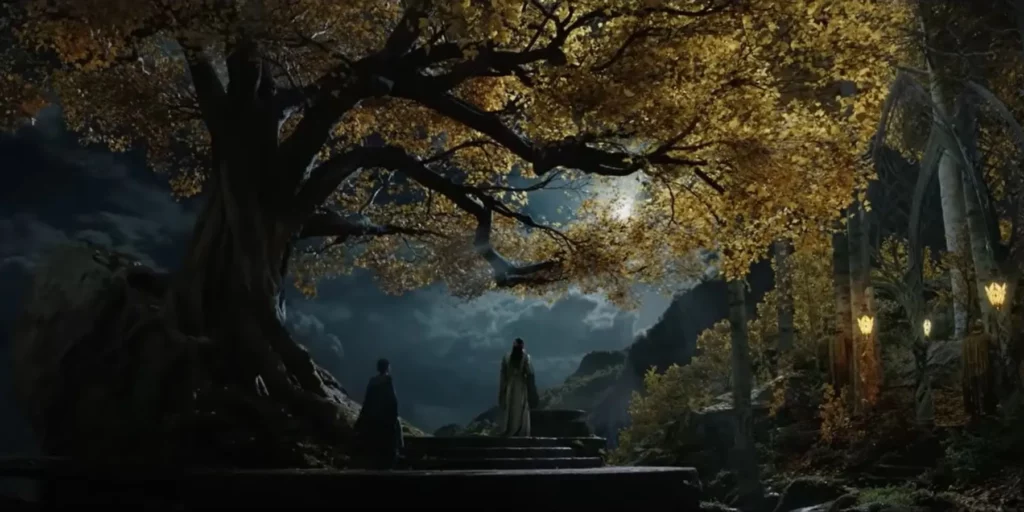
Just letting these glorious images rise and crest over you is an experience in itself. Bayona immerses the senses with a sure hand while story beats gently move along.
After being away from any new adaptation of Middle-earth for a decade the audience is beckoned to rediscover insanely lush Elven forests and Dwarven Halls at the pinnacle of their glory. I remember seeing various things in Peter Jackson’s LOTR — like decayed statues appearing subtly behind Frodo’s shoulder in the odd scene. In this Second Age timeframe Rings of Power is the ultimate way-back machine (we are talking thousands of years) to when those freshly-hewn statues still resonated from the original sculptor’s determined chisel. Likewise we sense the determination of showrunners Patrick McKay and J.D. Payne — building visual hints and connections to our existing ideas of what Middle-earth looks like while employing unique brushstrokes of their own. Bear McCreary shines with a luminous score. The opening theme crafted by Oscar-winner Howard Shore is surprisingly understated yet filled with omen (it is not heard in the opening episode, just the following 2-8).
Details and Grand Scale in Middle-earth
Production Design, Costumes, VFX and Tech Departments are firing on all cylinders here, mesmerizing you with rich details barely on screen for a scant few seconds before moving on to the next wondrous reveal. They’ll need to buy a big trophy case for all the Emmys. Trust.
It is satisfying to see such care put into everything. The scale of Tolkien’s Secondary World deserves it; and indeed these early episodes work hard to establish context to this newly envisioned world we Tolkien fans know as Arda. Newbies and casual viewers will not be at a loss, which is saying something considering the further reaches we are exploring. I particularly liked the ingenious use of Tolkien’s maps. They are ubiquitous (to the delight of every nerd in the house). The editors use clever cross-dissolves that sweep the audience across both a map and spectacular arial shots of New Zealand. Geographical names shine with golden letters as the map fades away — the letters have now become a convenient “lower-3rd” establishing our location. Such thoughtful touches deepen the immersion.
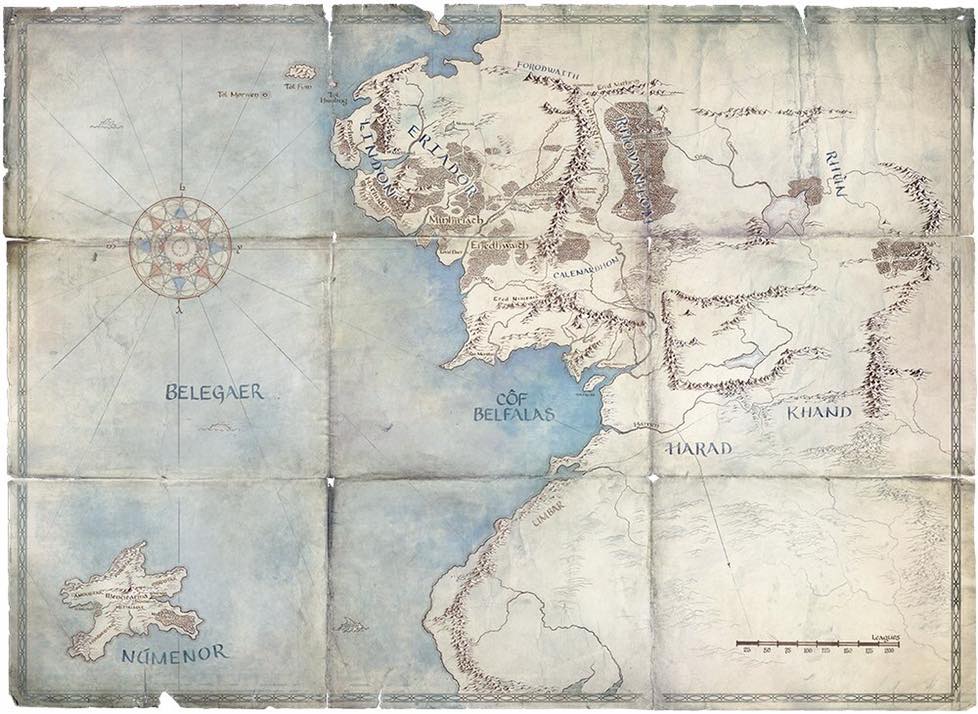
Actually, we are gifted with visits to places in Arda frequently discussed by academics and fans alike yet have NEVER been revealed on-screen. To me it is quite interesting, even thrilling to see these places!
Striking far afield from any other Tolkien adaptation, we are no longer confined to the geography of Bilbo’s journey or the events of the War of the Ring. Even though we won’t get to Númenor until Episode 3, a vivid series of gorgeous locales are at the forefront here: Lindon on the western shores of Middle-earth, the Southlands where Men dwell (which is indeed the far Southeast of Núrn before it was Mordor), Rhovanion where the Harfoots migrate, and above Eregion right up to Khazad-dûm’s unassuming western door. Another future gate to be built there will be significant and familiar. Striking deep into the Wilderlands, the Sundering Seas, the frozen wastes of Forodwaith, Rings of Power satisfies that wanderlust to see strange and distant lands from the pages of Tolkien.
And yes, everything I saw in the first two episodes feels very much like Tolkien, albeit with a sprinkling of new characters and plotlines he never penned.
Licensing Governs What We Witness Here
If you’re like me, you’ve certainly heard quite enough hand-wringing from folks worried that “The Appendices” of LOTR are barely enough to sustain a series. Look, the Tolkien Estate went ahead and licensed the 2nd Age stories as a complete package deal, with the intent that new creators could crystallize an epic story from them. Way back in time John Boorman had a chance at LOTR and it failed to manifest (thank heavens); then suddenly Ralph Bakshi created a remarkable first feature film adaptation of it. Also on television rights side there was the animation classic that won the Peabody Award — Arthur Rankin Jr. & Jules Bass’ The Hobbit. Later indie New Zealand filmmaker Peter Jackson would helm a worldwide 3-year juggernaut of cinema. Will you look at that! Such an evolution of different adaptations have appeared since Professor Tolkien himself sold the rights. I’m highly intrigued now to have five seasons of deeply artful portrayals of Middle-earth and that is an encouraging thought.
I’m looking forward to talking at the Thanksgiving table with family and dropping stuff about of The Fall of Númenor — yet this time everyone will get it.
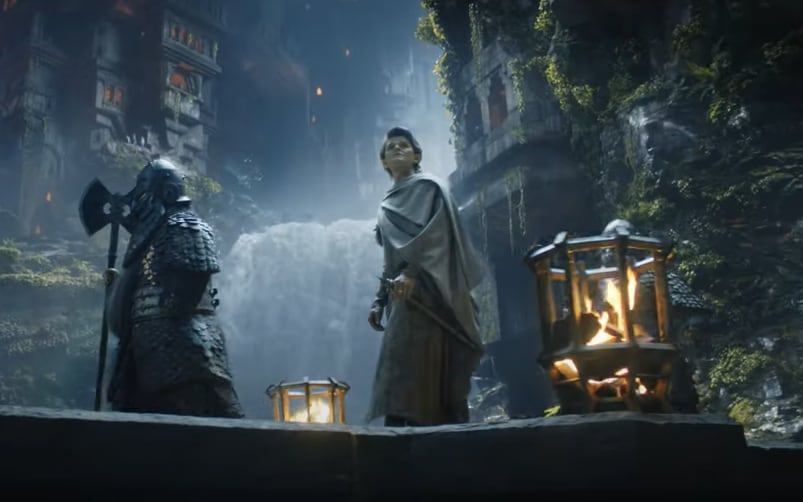
Granted, whether they stray too far from lore is yet to be seen, but I’m open minded. All signs here point to a careful foundation being built; meant to support epicness yet to come. Certainly we shall revisit this entire Season One after it’s completely available.
I am not envious of the Rings of Power writer’s room having such a unique challenge. They are not adapting, I sense, but rather it seems like a distillation. An alchemy of mixing ingredients guided by the Appendices. They are trying to distill the essence from the ancient fibers of pages that Tolkien insisted on inclusion in the 1955 publication of “The Return of the King,” much to his Publisher’s displeasure at the delay. He wanted the Appendices available to support his wider Legendarium. Of course, deviations and constricting of time are just going to happen, as they do in any adaptation requiring different idioms of delivering a well-told story. I would point to Miyazaki’s remarkable deviations from Diana Wynne Jones’ “Howl’s Moving Castle.” I see his adaptation as a blissful, rich distillation of her work. Though clearly not the novel, it stands as a unique, moving piece of art.

Is there A Prologue?
Yes, and it’s a doozy. This all-too-brief Prologue includes the shadow of Morgoth over the Two Trees and a gasp-inducing shot from The War of Wrath. Was that really Ancalagon the Black we just saw taking down a giant Eagle or was that some Fell Beast of Morgoth? Saruon appears in a stunning tableaux invoking a Frazetta painting dripping with evil — it is but a fleeting moment. This setup provides the context between the First and Second Ages that a general audience would need. Deep readers of Tolkien will not find “The Silmarillion” levels of detail in this highly-condensed opener. Galadriel narrates, naturally. She is but a child at this time, living in Tirion, conversing with her brother Finrod. No other siblings; so don’t expect First Age minutiae not included in the license. Emotions pure enough to fuel an Elven memory are Bayona’s main concern here. A few critical points of history are established and then we swiftly move on. Beleriand by name is not mentioned. We have Lindon and Eregion now as the centers of Elven life in Middle-earth.
But that brief moment in Valinor is genuinely lovely in the most Tolkienesque way.
The Strength of a Great Cast
To the show’s credit the many appealing characters played by a winning cast handle things flawlessly. Hands down, casting was crucial as it has been in previous adaptations. Note the scene where two Elves look each other in the eye and discuss metaphysical things in earnest. How refreshing a narrative placement for these ideas to live and breathe. Even if Tolkien didn’t specifically write them, I’m glad to see it in this type of television.
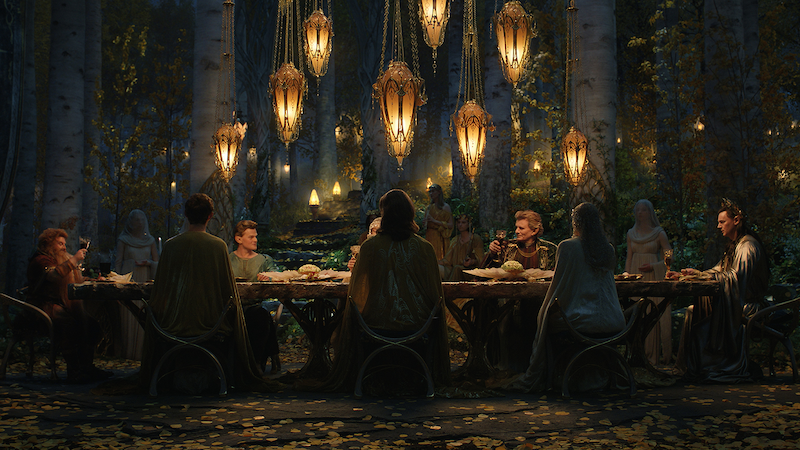
The grand design of these character’s arcs are only hinted at during the establishing efforts of Episodes 1 and 2 but the larger supporting legs of this giant table are already apparent:
- The journeys / ambition of Galadriel
- Southlanders in trouble
- Harfoots in the wild
- The inimitable Elrond/Prince Durin friendship
I know there’s supposed to be a 5th leg supporting the table — the rise of Sauron — but in these opening episodes he is nowhere to be seen, that we know of, either as Sauron or Annatar.
All of the secrecy in the world is piled up to shroud Sauron’s true identity from audience and characters alike. This is also true of The Stranger. As far as deliberate mysteries, I find these are the biggest two. We are all looking for signs of Annatar — the fair form Sauron could take to fool others. Fan theories are rampant. If we are playing a “Where’s Waldo” among characters looking for Annatar, well, I’d say I cannot even tell who Waldo is yet. A new human character from the Southlands named Halbrand has opening dialogue which makes me alert: “Looks can be deceiving.”
My current favorite theories about The Stranger (bracingly portrayed by Daniel Weyman) include him being one of the Istari, the Wizards of the Third Age, or even better being the Maiar Eönwë himself, arriving in a meteor to suss out the presence of Sauron. Let the guessing games continue with hearty speculation! Will fortune favor this bold choice by the writers? I’m very curious indeed.
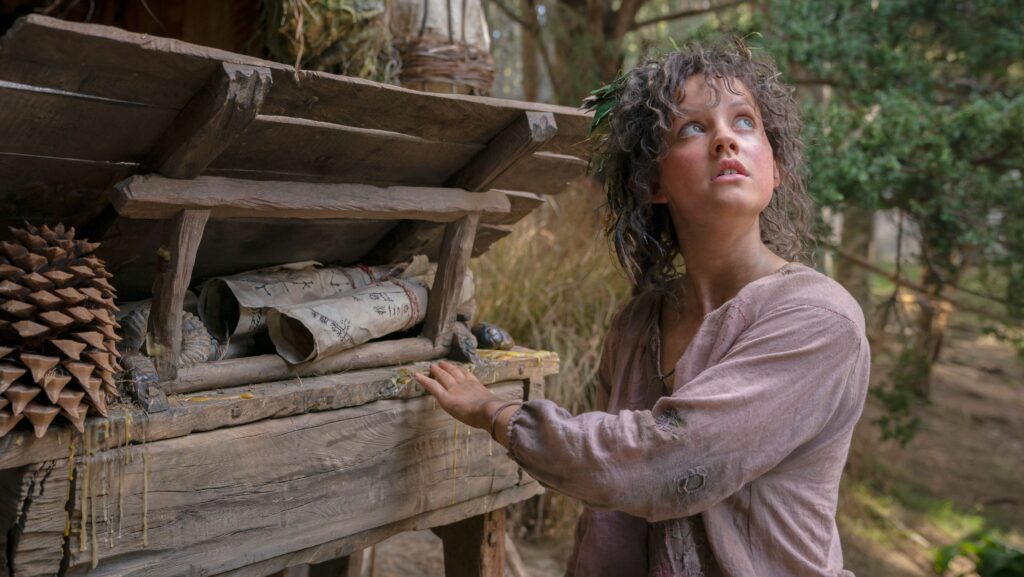
It’s quite an interesting dance the showrunners have found themselves waltzing. From interviews with McKay and Payne we know things will get squishy with a very condensed timeline. Yes, two Durin’s are alive at the same time, I know, but let us see where this goes…
The Height of Dwarven Might
My favorite thing of this whole endeavor, so far, is the realization of Khazad-dûm — the mightiest Kingdom of the Dwarves under the Misty Mountains. Destined to be found when the first forefather of all Durins looked into the Kheled-zâram, the Mirrormere, and beheld the crown of stars above his head. A location forever cemented in our minds as a ruined, Balrog-infested nightmare; but here how things are so different, so fresh, so alive!
We get the dynamic interplay between Robert Aramayo’s elegant Elrond and his dear friend Prince Durin IV, a cinderous Owain Arthur. Against the backdrop of the a truly extraordinary, verdant Dwarven Kingdom these two bicker and fight and test and forgive and reconcile all within this one episode and I’m immediately drawn in. I just loved this stuff and how it represents Tolkien’s dynamic relationships between Elves and Dwarves. The vibrant Sophia Nomvete brings life to Disa, the better half of the fiery Dwarf Prince, and her energy uplifts everything.
Fans are going to ship hard for Durin IV and Elrond, mark my words.
Celebrimbor is ready to steal the show at any minute, you can catch magnificent glimpses from Charles Edwards. You can tell he is the lightning about to strike somewhere in the distance. Yet after his character is tantalizingly introduced he then stays offstage, waiting outside the door (literally at one point).
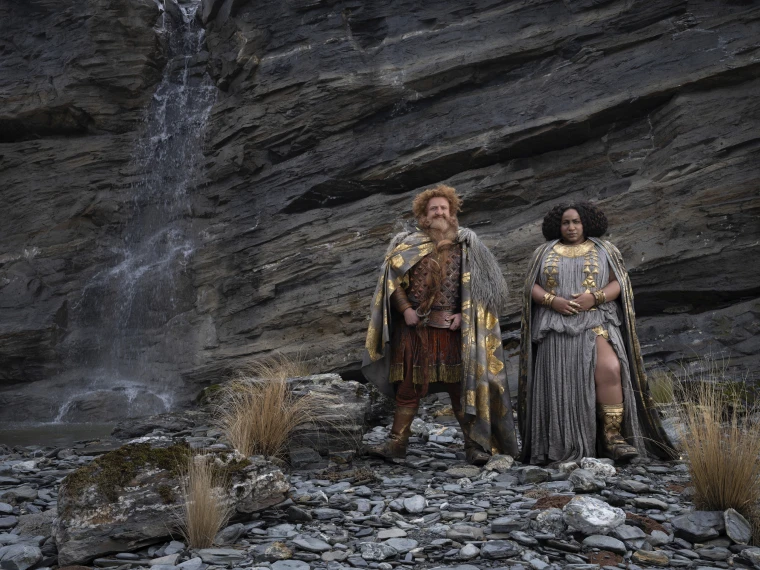
What Else is Good?
The Harfoots are amazing. Suddenly everyone will press “Pause” to freeze frame a closer inspection of those props and items. Great credit to the Property Masters and Art Department — what they came up with is grand. It is delicious to see how the Harfoots keep themselves hidden yet immediately can be set adrift to migrate to other places where fields and weather might be more kind, as generations demand over time. Thus continue traditions of the finest agrarian ingenuity deserving of early Hobbits.
A most satisfying portrayal of the Southlanders bears a dynamic worth exploring. Descendants of Men known to have worshipped Morgoth have immediate tension between them and Sylvan Elves who watch over their lifelong settlements. Sharply-observant Arondir (Ismael Cruz Cordova) walks into the Public House and is glared down by all the patrons. I’m sure there are few who can smolder onscreen the way Cruz Cordova can smolder. He is mesmerizing to watch. As a fiery healer, Nazanin Boniadi is a good counterpoint to him. She and her son Theo (Tyroe Muhafidin) have a future part to play in much greater things, methinks, especially with that weird Sauron-infested blade Theo seems to have kept hidden away for no reason. After seeing these segments with the Southlanders you’ll never see Mordor the same way again. It’s rather, shall we say, lovely.
Playing a Bit Outside the Box with Lore
There’s a huge moment that might be way too SPOILERY for you but here we go, stop reading for two paragraphs then continue — it’s in the 1st Episode and we need to talk about this rather binary choice that was given to Galadriel. I don’t want to say, just yet, that any one leg of this table is a little wee bit wobbly — but if there were such a thing, this is it. This early serving of Galadriel’s motivations and actions are in many ways resonant and beautiful, but at one point when Gil-galad offers her to access the Gift of the Valar and return to the Undying Lands (what’s that about), there was a story-point I really had to get my head around. I worked too hard for it, actually.
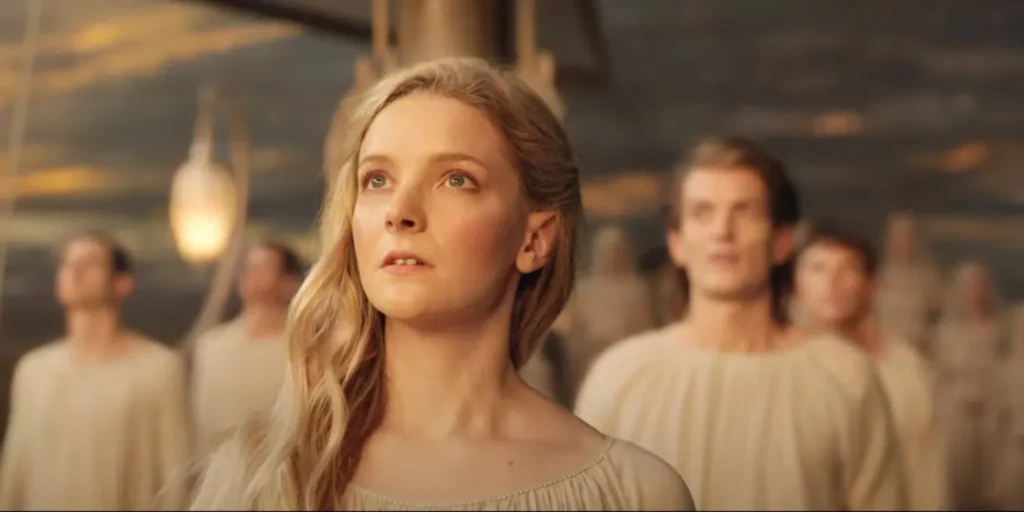
I wondered why such a powerful character would just jump from the ship right before it enters Valinor, leaving the most powerful Noldorin Elf adrift in the empty waves: no rations, no fresh water, no plan, nowhere to go. I thought for a moment, have they written themselves into a corner here? Then after sharing some thoughtful conversation with Tolkien Professor Corey Olsen and Matt Nerd of the Rings we figured this was maybe a lore-moment that would raise a few eyebrows.
Maybe it seemed really “out there” but it’s a binary choice ultimately to dramatize what Valinor looks like — as a place, as as destination for the sprit and body and soul. It occurred to me this huge set-piece is here for television audience’s sake. So a few Seasons moving on, when Ar-Pharazon seeks out this same place, audiences will recognize what is at stake. This is where books adapted into TV can vary the most wildly, folks, where big attempts at dramatizing the metaphysical can be, well, dictated buy the visual economy of televised storytelling. I daresay her standing on the shore and politely saying “No,” and refusing to even get on the boat would be rather dull in the end.
Me quibbling that aside, the ferocity and wisdom in Morfydd Clark’s eyes is compelling. She delivers a great performance as Galadriel, glints in her eyes of great tragedy and also light. Halbrand, played with a studied glare by Charlie Vickers, has a strange pouch around his neck bearing a strange sigil, and how quickly he hides it.
Being teased by strange mysteries hidden within a newly visualized Middle-earth is where this series is headed, and I’m glad to take the ride.
Once we get past this entire First Season’s run of 8 full episodes we shall have a better grasp, certainly, of how they manage to keep these plates spinning. One wonders, dimly, what changes we will see between this and future Seasons. The many riches on display in this first Season were produced solely in New Zealand — everything going forward will be new Heads of Departments, new crew, new studios, and perhaps a difference in approach and energy. That remains to be seen yet I am most curious.
An Overall Rating, But Only So Far
Giving an overall rating should really wait till then: but if we are all insisting then I’ll give these two Episodes a solid 8.5 out of 10, where things are yet to be resolved, this number will certainly change.
The Rings of Power is eager to please, as I said on Twitter. There is wonderment and a strong undercurrent of greatness that could be a real knock-out, if the stars align, or the Meteor Man arrives. One need not be afraid to enter gamely into Lore discussions (“Why is there even a Meteor Man?”) because from those open-handed chats we all learn and appreciate more about Tolkien — and what we love about him. Again, pass or fail, The Rings of Power surely will bring new readers with a healthy curiosity. And so in the end we get to engage and encourage an ongoing fandom.
That’s what I meant by “Everyone Wins.”
Much too hasty,
Quickbeam
Clifford Broadway is the Writer & Producer of the Award-Winning Documentary "Ringers: Lord of the Fans, a Co-Host for the weekly livestream "TORn Tuesday" hosted by TheOneRing.net on mutliple platforms. His articles on Tolkien and popular culture appear in "Famous Monsters of Filmland" and on DeviantArt, also within "The People's Guide To J.R.R. Tolkien" (Cold Spring Press)


